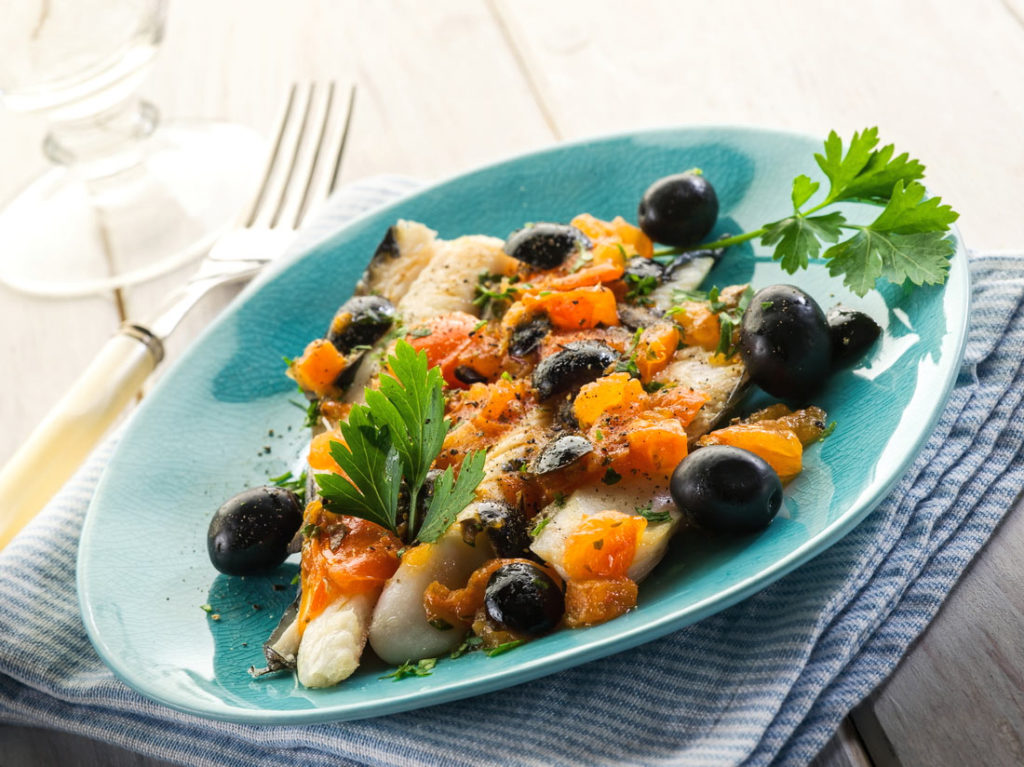This Cod Fillet with Black Olives and Fresh Tomatoes is a fresh, vibrant dish inspired by Mediterranean flavors. The flaky cod is cooked in a delicious blend of ripe tomatoes, black olives, and olive oil, creating a healthy, light, yet satisfying meal. It’s easy to make and perfect for weeknights or a special dinner.
Preparation Time
- Prep time: 20 minutes
- Cook time: 30 minutes
- Total time: 50 minutes
Ingredients (for four people)
- 4 cod fillets (about 5-6 oz each)
- 4 ripe tomatoes, diced
- 1/2 cup black olives, pitted and halved
- 2 garlic cloves, minced
- 1 small onion, finely chopped
- 1 tablespoon capers (optional for added brininess)
- 1/4 cup extra virgin olive oil
- 1/4 cup dry white wine
- 1 tablespoon fresh parsley, chopped
- Salt and pepper to taste
- Lemon wedges for serving
1 tablespoon is circa 15 ml, and a teaspoon is circa 5 ml.
Preparation Method
Step 1: Prepare the Tomatoes and Olives
Heat half of the olive oil over medium heat in a large skillet. Add the onions and garlic, sautéing until soft and fragrant, about 3-4 minutes. Add the diced tomatoes and cook for 5 minutes, allowing the tomatoes to break down slightly. Stir in the black olives and capers (if using) and continue cooking for another 2-3 minutes until everything is well combined.
Step 2: Cook the Cod
Season the cod fillets with salt and pepper. Push the tomato mixture to the sides of the skillet and place the cod fillets in the center. Drizzle the remaining olive oil over the fish. Pour in the white wine, cover the skillet, and let the cod cook for 8-10 minutes or until it flakes easily with a fork.
Step 3: Finish and Serve
Once the cod is cooked through, remove the skillet from heat. Garnish the dish with fresh parsley and serve with lemon wedges on the side for extra brightness.

Tips and Tricks
- Perfectly Cooked Cod: The cod is done when it flakes easily with a fork. Be careful not to overcook it, as it can become dry.
- Optional Heat: If you prefer a bit of spice, add a pinch of red pepper flakes to the tomato mixture while sautéing the garlic and onion.
- Wine Substitute: If you prefer not to use wine, substitute with a splash of vegetable or fish broth for added depth of flavor.
Serving Suggestions
- Rice or Couscous: Serve the cod with rice or couscous to soak up the delicious sauce.
- Crusty Bread: A slice of warm, crusty bread pairs perfectly to mop up the olive and tomato juices.
- Steamed Vegetables: Lightly steamed green beans or asparagus complement this dish beautifully.
Wine Pairing
- General Wine Suggestion: A crisp Sauvignon Blanc or Pinot Grigio pairs well with the dish’s fresh, light flavors.
- Bulgarian Wine: A refreshing Dimyat or Misket from Bulgaria would be an excellent choice, balancing the acidity of the tomatoes.
Nutritional Information (Per Serving)
- Calories: 360 kcal
- Protein: 34g
- Fat: 20g
- Carbohydrates: 10g
- Fiber: 2g
- Sugar: 4g
- Cholesterol: 85 mg
- Sodium: 380 mg
Dietary Modifications
- Gluten-Free: This recipe is naturally gluten-free as long as all ingredients (such as the capers or olives) are certified gluten-free.
- Dairy-Free: This recipe is naturally dairy-free.
About Cod Fillet with Black Olives and Fresh Tomatoes
This Cod Fillet with Black Olives and Fresh Tomatoes is a light yet flavorful Mediterranean-inspired dish. The combination of tender cod, juicy tomatoes, and briny black olives makes this recipe healthy and delicious, perfect for a family dinner or a special occasion. The olive oil and wine bring out the freshness of the ingredients, giving each bite a delightful burst of flavor.
Cultural Context
Mediterranean cuisine is known for its emphasis on fresh ingredients like fish, tomatoes, olives, and herbs, reflecting the simplicity and richness of life along the coast. Cod (треска in Bulgarian), a popular fish in many Mediterranean countries, is often cooked in light sauces that let its natural flavors shine. This dish is reminiscent of traditional Mediterranean meals, where fresh produce and healthy fats like olive oil are central to the cuisine. Adding black olives and white wine further enhances the dish’s Mediterranean roots, perfectly representing coastal European cooking.


